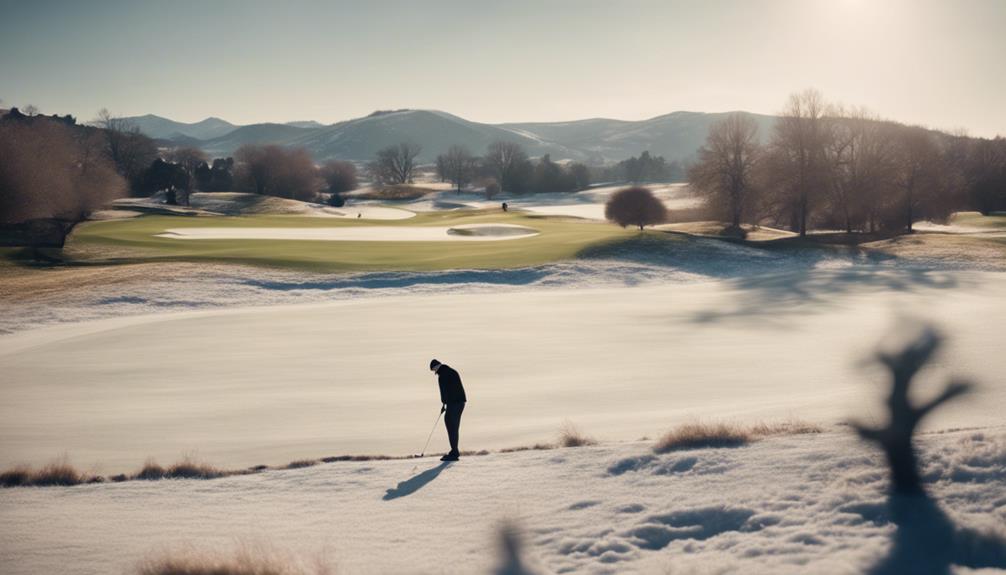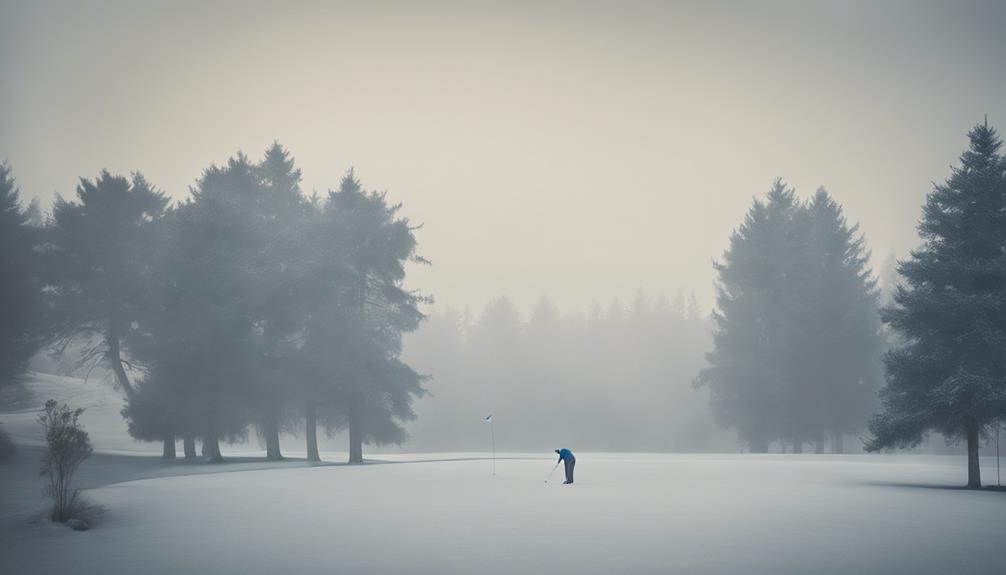- 7 Top Flite Golf Clubs XL for Improved Performance - September 28, 2024
- Top Flite Golf Clubs: Top 5 Reasons to Choose Them - September 28, 2024
- Top 3 Golf Club Fitters for a Perfect Swing - September 28, 2024
You can start playing golf sooner than you think, as many public golf courses remain open during winter months, although private clubs often close to protect their greens. You can still book tee times, but be sure to check the forecast and adapt to colder temperatures, which may cause frost delays. Unique winter landscapes present fresh challenges, and unseasonably warm weather can even lead to early course openings in some regions. As you prepare to hit the links, you'll want to learn more about the advantages and preparation strategies for winter golf to make the most of your time on the course.
Key Takeaways
- Public golf courses typically remain open during winter months, while private clubs may close to protect greens from harsh weather.
- Early course openings can occur in regions with unseasonably warm weather, such as Metro Detroit, where Huron-Clinton courses opened a month ahead of schedule.
- Golf courses in the Midwest, Western Wisconsin, and Michigan may open earlier or later depending on weather conditions, with some courses opening as early as mid-April.
- Checking specific course hours and availability is recommended to ensure smooth tee-off, as winter weather can impact course conditions and availability.
Winter Golf Course Availability
As winter's chill sets in, public golf courses typically remain open to accommodate your winter golf outings, while private clubs often shut their gates to protect their greens from the harsh weather conditions. You can still book tee times and enjoy the crisp winter air, but it's crucial to check the forecast beforehand to verify the course is accessible.
Colder temperatures can affect ball performance and course conditions, so be prepared for potential frost delays. When you arrive at the course, you'll notice the winter landscape has transformed the aesthetics of the greens and fairways, offering a fresh perspective and unique challenges.
Take your time to adjust to the new environment, and don't hesitate to ask the pro shop for guidance on maneuvering the winter course. With a little planning and patience, you can make the most of your winter golf outings on public golf courses, which remain open and ready for you to take on the challenges of the season.
Challenges of Winter Golf Play
As you step onto the winter golf course, you'll face a range of challenges that'll test your skills and patience.
Cold weather conditions will affect your ball's performance, and snow cover will obscure fairways and greens, making navigation tricky.
You'll need to adapt to these winter golf obstacles, including frost delays and the potential for snow-related damage to the course.
Winter Golf Obstacles
Winter golf play presents a unique set of challenges that can greatly impact your game, from cold temperatures affecting ball performance to snow cover obscuring fairways and complicating gameplay.
As you step onto the course, you'll need to adapt to the harsh winter conditions. Colder temperatures will reduce your ball's distance and alter its roll, making it essential to adjust your swing and strategy. Meanwhile, snow cover may hide the fairways, forcing you to search for your ball in the snow – an exciting but challenging experience.
Frost delays are also common in winter golf, requiring you to be patient and flexible with your tee times. Additionally, heavy snowfall can damage the course, leading to issues like Snow Mold, which can affect the turf's quality in the spring.
Despite these obstacles, winter golf offers a unique and adventurous experience. Golf courses open during this time welcome golfers who are enthusiastic to take on the challenges and enjoy the thrill of searching for white balls in the snow.
With the right mindset and preparation, you can master the winter golf obstacles and enhance your overall game.
Cold Weather Conditions
You'll need to contend with cold weather conditions that markedly impact your game, as frigid temperatures alter the physical properties of golf balls, affecting their flight patterns and distance. The cold weather impacts your ball's performance, resulting in reduced distance and altered flight paths. This means you'll need to adjust your swings and strategies to compensate for the temperature effects.
To overcome these challenges, it's crucial to invest in winter equipment designed to perform well in cold conditions. Look for golf balls with specialized cores that maintain their elasticity in low temperatures, ensuring consistent flight patterns. Additionally, consider using clubs with larger sweet spots to increase your chances of making solid contact in the cold.
Understanding the temperature effects on your game will help you make informed decisions on the course. By adapting to the cold weather conditions, you can still enjoy a great round of golf despite the winter obstacles. Remember, mastering winter golf requires a deep understanding of how cold weather impacts your game, so be prepared to make adjustments and take on the challenges that come with playing in the cold.
Snow-Covered Course Challenges
Frozen landscapes transform golf courses into challenging winter wonderlands, where snow-covered fairways and greens conceal hidden obstacles and demand meticulous attention to navigate. As you step onto the snow-covered course, you'll face unique challenges that test your skills and patience.
Here are three key considerations to keep in mind:
- Snow visibility issues: Snow cover can obscure fairways and greens, making it difficult to judge distances and lie angles. You'll need to rely on your intuition and experience to navigate the course.
- Frost impact effects: Frost delays may prevent tee times from starting on schedule, requiring you to be patient as the course thaws.
Searching for white golf balls in snow adds an extra layer of challenge to winter play, but the serene and picturesque environment can also alter the typical golfing experience. By understanding these snow-covered course challenges, you can adapt your game and enjoy the unique experience of winter golf.
Advantages of Golfing in Winter

Fewer players on the course during the colder months translate to a more serene and uninterrupted golfing experience, allowing enthusiasts to focus on their game without the distractions that come with peak season crowds.
You'll appreciate the winter tranquility, which enables you to concentrate on your technique and strategy. The unique challenges presented by cold temperatures can actually aid in skill development, as you're forced to adapt to changing course conditions.
For instance, you'll need to adjust your swing to compensate for the colder air, which can help refine your technique. Additionally, the lack of time pressure during winter rounds allows you to take your time and make more deliberate shots.
Heated golf carts also enhance your comfort level, allowing you to stay warm and focused throughout your round.
Preparing for Winter Golf Outings
As winter golf approaches, your wardrobe and equipment choices become vital to a comfortable and successful outing, requiring careful consideration of layering, accessories, and specialized gear. To guarantee a great winter golf experience, you'll want to focus on the following key areas:
- Layering techniques: Start with moisture-wicking base layers to keep you dry and comfortable in cold weather. Add insulating layers and a waterproof shell to protect against wind and precipitation.
- Winter accessories: Invest in proper accessories like hats, gloves, and waterproof footwear to enhance comfort and grip. This is essential for maintaining control over the clubs, especially when wearing multiple layers.
Adjusting to Winter Course Conditions

You'll need to adapt your game to winter's harsh conditions, where cold temperatures, snow cover, and frost delays can greatly impact your performance.
As you step onto the winter course, you'll notice the ball doesn't travel as far, and its behavior is less predictable. To compensate, make ball performance adjustments by selecting the right clubs and adjusting your swing technique. Winter swing techniques require a more controlled tempo and a slightly shorter backswing to account for the cold air's effect on distance.
Snow cover can obscure fairways and greens, making it essential to use visibility aids like colored balls to track your shots more easily. Additionally, ground conditions can become hard and frozen, leading to unpredictable bounces. Approach shots should be gentle to avoid unintended consequences.
Be prepared for frost delays, and schedule your tee times accordingly. By adapting to winter's challenges, you'll be better equipped to navigate the course and maintain a strong game despite the harsh conditions. By incorporating these adjustments into your winter golf routine, you'll be well on your way to mastering the winter course.
Early Golf Course Openings in Metro Detroit
As you're likely aware, Metro Detroit's unseasonably warm weather has prompted some golf courses to open their doors earlier than usual.
You're probably enthusiastic to get back out on the links, and you're not alone – several local courses, including Huron-Clinton courses, have already started operations a month ahead of schedule.
Now, let's take a closer look at how this early opening is unfolding and what it means for you, the golfer.
Early Openings Unfold
This uncharacteristic warm spell in early March 2024 has prompted several Metro Detroit golf courses to open their doors, and their greens, a month ahead of schedule.
As a golfer, you're likely feeling the early season excitement and enthusiasm to get back out on the course. And, you're not alone – course managers are reporting increased inquiries about course availability, reflecting Michiganders' willingness to return to outdoor activities after winter.
Here are a few key details to know about these early openings:
- Huron-Clinton courses are open a month earlier than usual, indicating a strong demand for tee times.
- Willow Metropark is operational, with weekday and weekend rates set at $31.
As you plan your tee times, keep in mind that these early openings are a result of springtime trends, and course managers are optimistic about maintaining quality conditions throughout the season.
With the warm weather here to stay, it's time to dust off your clubs and get back out on the course!
Warm Weather Boost
Golfers are seizing the opportunity to get a head start on the season, capitalizing on the unseasonable warmth that has swept across Metro Detroit, triggering a wave of early course openings.
As you take advantage of these favorable conditions, you'll notice that some courses are opening a month earlier than usual, like the Huron-Clinton Metroparks courses.
This shift in golf course trends is largely driven by seasonal golfer behavior, as enthusiasts like you rush to get in a round during the rare early spring warmth. The climate impact on golf is evident, with courses adapting their operations to the fluctuating weather patterns.
You'll find that local courses are working diligently to prepare and maintain course conditions, ensuring quality play for early season golfers.
As you book your tee times, you'll likely notice increased demand, but courses are rising to the challenge.
Take advantage of this warm weather boost and get a head start on your golfing buddies – the season is shaping up to be an exciting one!
Open Golf Courses by Region

You can tee off in various regions, where specific golf courses have already opened their doors to welcome you. As you plan your golfing adventure, consider the regional climate and seasonal demand that influence golf course hours.
Here are three regions with open golf courses:
- Midwest: In Iowa, Fox Ridge Golf Course and Rice Lake Golf & Country Club are open with carts available for play. Minnesota features multiple open Public Country Club (PCC) courses, including Albion Ridges Golf Course and Boulder Pointe Golf Course, with online booking available.
- Western Wisconsin: Kilkarney Hills Golf Course and St. Croix National Golf Course are open for play, with online booking required for tee times.
Note that the average opening date for Fargo area courses is typically mid-April, but early spring weather might accelerate openings by 2-3 weeks compared to previous years.
Always check with the specific course for their current hours and availability to guarantee a smooth tee-off experience.
Frequently Asked Questions
What Is Golf Season in Florida?
You'll find that Florida's golf season, influenced by its subtropical weather, typically runs from October to May, with peak play during winter months, featuring seasonal tournaments, and requiring meticulous golf course maintenance to guarantee ideal playing conditions.
Are Golf Courses Open Year-Round in Myrtle Beach?
You'll find that in Myrtle Beach, you can tee off year-round, thanks to the mild weather, with courses adapting maintenance practices to preserve turf quality, and offering seasonal rates to attract golfers during the off-peak season.
Conclusion
As you step onto the frosty greens, the crisp winter air invigorates your senses. You've prepared for this moment, adjusting your swing to the cold, hard ground.
Imagine playing a round at Oakland Hills Country Club in Michigan, where the snow-covered trees create a serene backdrop. By understanding winter golf course openings, you can seize the opportunity to experience the thrill of a winter round.
Picture a peaceful morning at Oakland Hills, where the calm silence is only broken by the sound of your ball flying through the frosty air.




